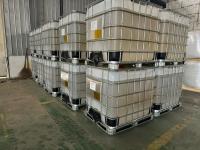Our Products
Product Center / polyamine of magnafloc LT-31 equivalent models can be replaced by Chinafloc


Polyamine is a general term for a class of cationic, water-soluble polymers produced by the reaction of epichlorohydrin with dialkylamines or other amine-containing monomers. The most common industrial polyamines used in water treatment are epichlorohydrin–dimethylamine (EPI–DMA) polymers. Their cationic nature makes them highly effective in coagulation and flocculation processes, as they neutralize the negative charges of suspended solids, colloids, and natural organic matter in water.
The main application of polyamine is in water and wastewater treatment as a primary coagulant or a coagulant aid, though it also has roles in papermaking, oil & gas water clarification, textile wastewater treatment, and other industrial separation processes.
The main application of polyamine is as a primary coagulant in water treatment systems. Most suspended solids, clay particles, and natural organic matter carry negative surface charges, which cause them to repel one another and remain dispersed in water. Polyamine, being strongly cationic, neutralizes these charges and destabilizes the colloidal suspension.
Once charge neutralization occurs, the destabilized particles collide and form microflocs. These microflocs can then be further agglomerated by other flocculants (like polyacrylamides) into large, dense flocs that settle or float rapidly.
Key uses in this role include:
Drinking water treatment plants – Polyamine can be used to replace or partially replace inorganic coagulants such as alum or ferric chloride, reducing sludge production and residual metal content in treated water.
Industrial process water treatment – In industries requiring high-clarity process water (e.g., electronics, pharmaceuticals, beverages), polyamine helps achieve low turbidity and low suspended solids.
A major main application of polyamine is in municipal and industrial wastewater treatment, especially for effluents containing fine suspended solids, colloidal matter, and color bodies.
In municipal wastewater treatment plants, polyamine is often used:
In primary clarification to remove solids before biological treatment.
In tertiary treatment for final effluent polishing to meet discharge turbidity limits.
As a sludge dewatering aid when combined with other polymers.
Polyamine is widely applied in:
Textile wastewater treatment – Removes dyes and color by binding with dye molecules and suspended fibers.
Pulp and paper effluent treatment – Removes lignin derivatives, fines, and color from paper mill wastewater.
Mining wastewater treatment – Clarifies mine tailings water, especially where color or fine colloids are present.
Food and beverage wastewater – Removes organic load and suspended food particles before discharge or biological treatment.
One of the specialized main applications of polyamine is color removal. Many natural surface waters and industrial effluents contain color caused by:
Humic and fulvic acids (natural organic matter)
Dye molecules from textile and printing industries
Lignin derivatives from pulp and paper manufacturing
Polyamine’s cationic charge binds to the negatively charged sites of these color-causing compounds, forming insoluble complexes that can be removed by sedimentation or flotation.
Another main application of polyamine is in oilfield water treatment, especially in:
Produced water clarification – Polyamine helps separate oil droplets and suspended solids from produced water, enabling discharge or reuse.
Injection water treatment – Prevents fouling of injection wells by removing suspended solids from water used for secondary recovery.
In these cases, polyamine is valued for its stability under high salinity and varying pH, common in oilfield operations.
In the papermaking process, polyamine plays two important roles:
Wet-end additive – Improves retention of fines and fillers by neutralizing charges on fibers and particles.
Wastewater clarification – Treats white water and mill effluents to recover fibers and improve water reuse.


